Life insurers in continental Europe have been grappling with a combination of cost, regulatory, and interest rate challenges for much of the past decade. The COVID-19 pandemic has accelerated those challenges by adding pressure on life insurers’ costs, solvency, and investment yield, forcing necessary investments in digitalization.
Now the challenge for incumbents is to learn from these developments so they can be better prepared for the future and avoid becoming trapped in a downward spiral.
To be sure, some players have been better able to cope with these challenges than others. Insurers implemented cost reduction programs and investments in the digitalization of their back and front ends.
Many shifted their product focus from traditional guarantees toward hybrids and unit-linked solutions. Nevertheless, growth has been limited to markets where the majority of players adapted to the new environment, and performance has been mixed as a result.
TOP 5 European Insurance Markets have had mixed performance on KPIs
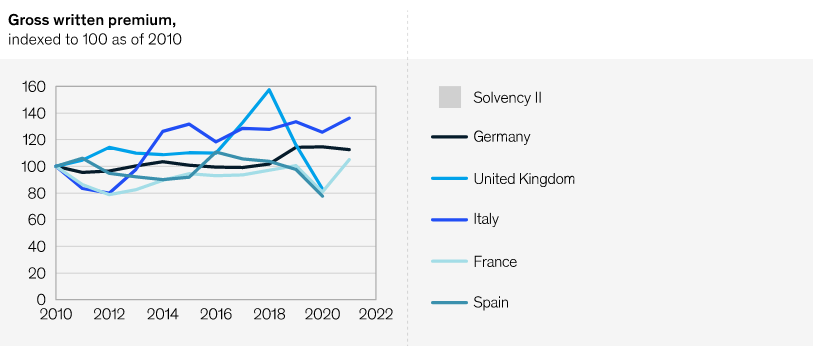
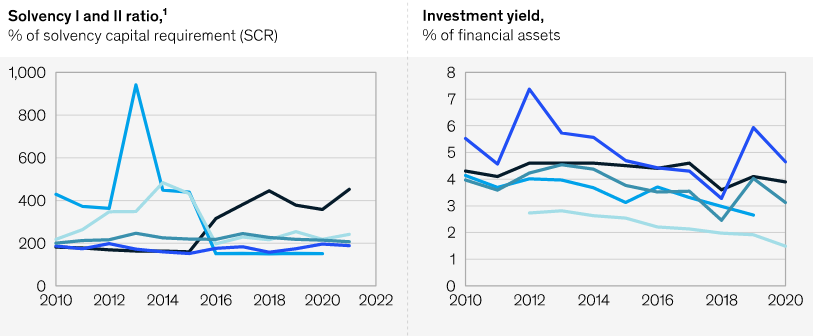
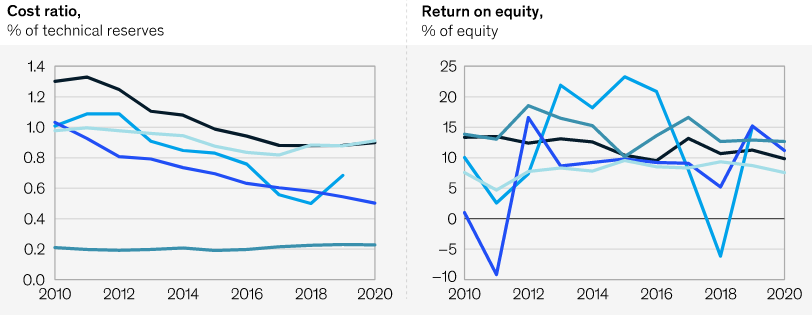
Underlying challenges affecting the sector persist
First, since 2010, insurers have failed to reduce their overall costs (as opposed to costs as a percentage of reserves). Cost ratios fell in each of the top five European markets, except Spain because of increasing reserves.
Second, regulatory pressure is showing no signs of abating. Rules such as the IFRS 17, which will come into force on January 1, 2023, and rules tightening up local consumer protection significantly deplete capacity and are challenging the traditional value proposition of life insurers.
Last, the era of ultralow interest rates has brought challenges.
While insurers have naturally sought to boost returns to offset the meager returns from traditional fixed-rate investments, the relatively high regulatory capital requirements involved have made this a difficult proposition.
Even with increasing rates driven by the unprecedented inflation since first quarter 2022, life insurers still need to deal with these issues due to the long duration of low-yielding assets in their books (see TOP 20 U.S. Life Insurers). This can be particularly challenging for smaller insurers that do not have the scale to justify assigning large teams to monitor risks associated with smaller asset classes such as renewables and infrastructure.
Despite this challenging environment, new players, such as consolidators, have entered the market and have shown that insurers can still create value. Incumbents can learn from such players to become better prepared for the future. The time has come for insurers to make some bold strategic decisions.
Global M&A Market: The neglected lever?

Many insurers still focus on organic growth by coming up with attractive new products or by cooperating with strong digital partners for superior distribution. To truly create value from this lever, insurers need to generate a minimum of roughly €2 billion in annual premiums to remain competitive, meaning an insurer with €500 million in premiums would need to grow by 15% per year for the next ten years.
Another way to accelerate this growth journey is through consolidation. M&A helps create scale, thereby helping to reduce costs and enabling insurers to finance investments in digitalization, new product offerings, and superior asset and liability management (ALM).
Previous McKinsey research has found that companies more active in M&A outperform their peers. In life insurance, although the acquirer can profit from scale, the seller benefits from divestments because those result in freeing up capital at the group level. The seller, however, needs to keep fixed costs (such as overhead costs) under control if only part of the business is sold (see Mergers & Acquisitions (M&A) in the Global Insurance Industry).
Moreover, companies with a more targeted approach outperform those that focus simply on scale. This means that insurers and consolidators should aim for scale while focusing on acquiring portfolios that fit their own strengths or that help them build the skills they need to improve efficiency.
Companies active in M&A also benefit from the ability to divest unprofitable parts of their business.
Despite a decline in M&A since 2012, we expect sector consolidation to rise in priority in the medium term as a response to the combination of pressures of scale, worsening market conditions, and the increasing difficulty of growing organically. Historically, consolidation has tended to follow periods of crisis. This introduces the prospect of more active dynamics in the life insurance M&A market, potentially improving overall performance.
The Global M&A market

Learning from successful closed-book consolidators
In a declining life insurance M&A market, closed-book deals have become an increasingly important part of life insurance M&A in continental Europe since the first deal in 2012.
Momentum accelerated from 2014 to 2015, with the deal count in the European Union overtaking that of the United Kingdom and Ireland combined and with Germany becoming the strongest continental market. Deal flow leveled off in 2020, however, because of the pandemic.
Closed-book deals are gaining an increasing share of life insurance MGAs
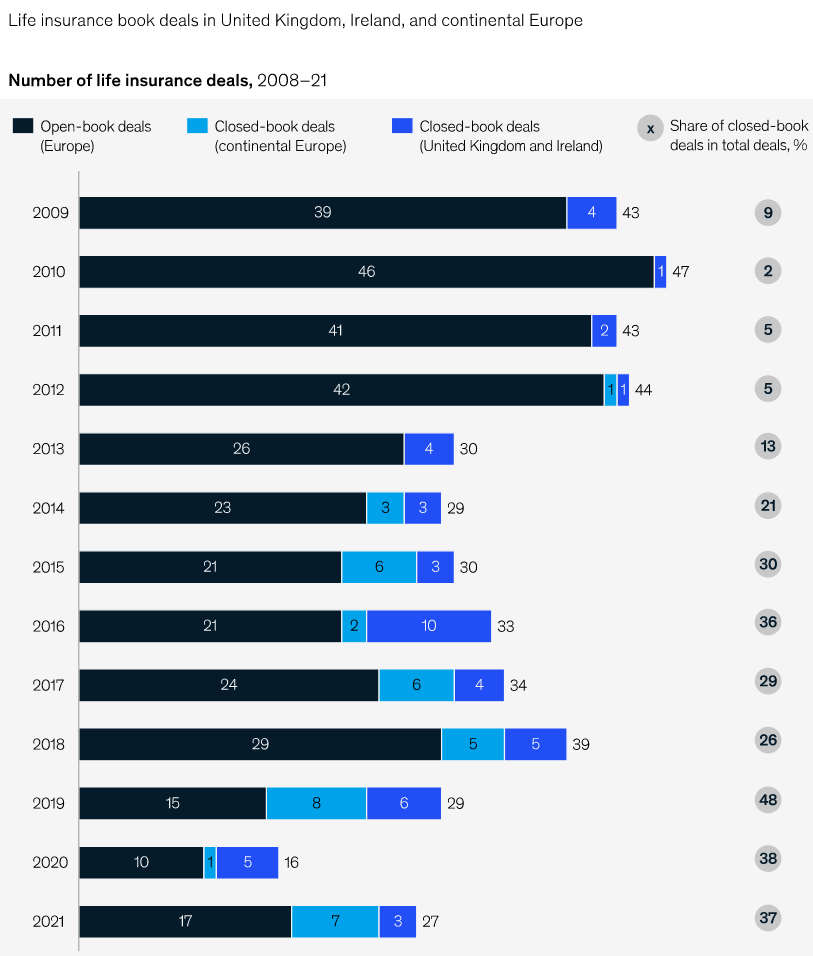
Three types of closed-book players have emerged in Europe
Internal runoff
In Germany, at least six life insurers have said they are now managing their closed books via a separate entity. These entities typically try to keep their costs under control, leverage their customer base for scale, cross-sell, or simply avoid complex transformations.
Purely external closed-book consolidators
Most consolidators began as purely closed-book consolidators, acquiring closed books or closing them during the acquisition. This ensured that they could focus on their core strengths and the efficient management of in-force business (see Global Risk Management Survey). These consolidators typically focus on operational excellence, improved capital management, or superior asset and investment management.
External closed-book consolidators with new business
Some consolidators that have been unable to achieve their target growth rates through acquisition alone have started opening their books in certain markets or acquiring new open books in an effort to grow. These consolidators typically generate additional value by selling products with a better new-business margin, such as biometric-risk coverage or unit-linked products.
The external closed-book category has two identifiable subtypes

Efficient operational platform. These consolidators focus on an efficient operational model via improved processes, digitalization, and a strong IT platform. They rethink their sourcing strategy and optimize their office locations. These insurers often outsource the asset management function or reduce interest rate risk, enabling them to cash out freed-up risk capital.
Superior asset management platform. These consolidators run on a solid IT and operational platform but mainly leverage sophisticated investment management skills, such as using cash-efficient ALM and improved strategic asset allocation (SAA) or deploying a higher risk appetite. The ultimate owner of the platform often handles asset management, which typically delivers higher returns and offers the owner a source of permanent capital.
As we laid out in our February 2021 report,early signs suggest that closed-book consolidators are better suited than incumbent life insurers to pull the required growth levers.
In Germany, for example, there are signs that external closed-book consolidators add value to the entire life insurance market. First, they reduce costs, increase investment yield, and manage their capital more efficiently, resulting in a significantly improved ROE after the acquisition of a closed book. Second, there are no signs of increasing churn rates after an insurance group sells its closed books to consolidators.
Compared with external closed-book consolidators, current data for Germany indicate that internal runoff entities haven’t managed to reduce administrative cost ratios.
Furthermore, they haven’t improved investment yield and ROE in the same way that external closed-book consolidators have done. Additionally, internal runoff portfolios have experienced a slightly higher churn rate after closure, while external closed-book consolidators have managed to reduce churn.

Moving consolidators to the next level
Most consolidators have specialized in their respective strengths, often focusing only on some of the five levers for value creation we discuss: operational excellence, investment, capital management, technical excellence, and commercial uplift.
Yet to fully maximize efficiencies, insurers should apply all of them, while at the same time focusing on building a lean, specialized business model and not being distracted by regulatory and other add-ons (such as reporting in different accounting standards).
Operational excellence
Within the first five years after the acquisition of a closed book, consolidators that focus on building efficient operating platforms have tended to reduce costs, while internal runoff entities have not been able to do so. However, consolidators with a focus on superior asset management platforms still have some potential if they strengthen their operational platforms.
Investment
The consolidators that are focusing on the investment lever generally have already managed to improve investment yield. But other consolidators have been derisking their portfolios by shifting into safe-haven assets such as government bonds to free up risk capital.
Capital management
Most consolidators have already reduced their equity after acquiring closed books. However, others—especially internal runoff entities—can still improve on their capital management.
Technical excellence
Life insurers have three sources of profit: returns from risk, investments, and cost management. Indications suggest that most external consolidators lack sufficient focus on the required skills, making them unable to improve their risk results.
In an increasingly competitive environment, consolidators should pay more attention to the talent and skills required for achieving effective risk returns.
Commercial uplift. While external consolidators have experience with reducing churn, internal runoff entities have a mixed track record and need to improve management of their churn rate.
Outlook: Three areas where we see developments
The following three trends could emerge among consolidators in the near future.
Consolidator deals
In the medium term, we expect to see more M&A deals by consolidators. In the past two years, an increasing number of incumbent life insurers have been rethinking their geographic footprint, selling to other incumbents or consolidators, and narrowing their portfolio focus to their core markets. While this momentum will be slowed down by current market volatility, the underlying trend is likely to persist.
Customized portfolio deals
Specifically, we expect to see more activity in relation to customized insurance portfolios, rather than the outright acquisition of a company, for two reasons:
First, within closed-book deals, the number of portfolio deals has increased recently, indicating that consolidators are starting to focus on acquiring portfolios that match their own strengths.
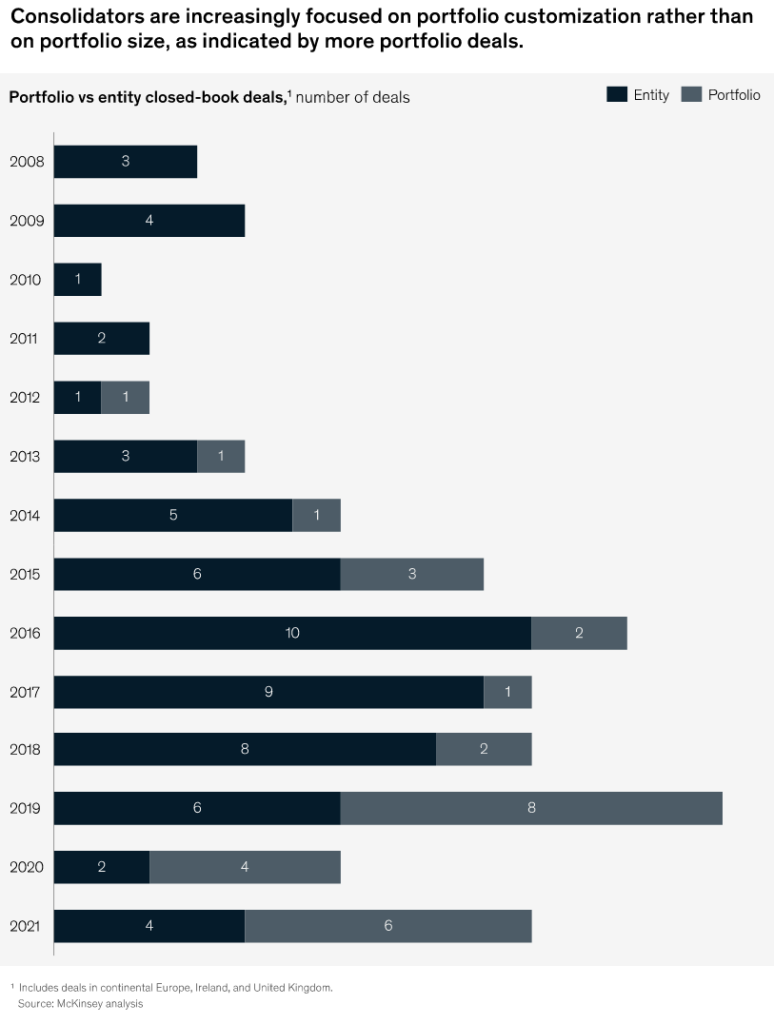
Second, as seen in the United States, smaller deals with more focus on skills and product diversification generate more value. In part, this is because portfolio deals typically involve the transfer to the acquirer of employees who are highly specialized. However, to ensure value creation, fixed costs need to be addressed on the seller side. The price of the acquired portfolio reflects this.
McKinsey analyzed the price-to-book multiple, by size, of the acquired portfolio in 22 life insurance deals. While the smallest quarter of the evaluated sample had an average price-to-book multiple of 0.16, the largest quarter had a multiple of only 0.05, meaning that smaller and likely more targeted and customized books are more highly prized.
More open-book acquisitions by closed-book consolidators
In the past two years, closed-book players have entered the open-book market, possibly because of lower supply and increased competition on the closed-book market. However, not all consolidators followed the same strategy.
While some focused their open-book activities only on specific markets, others acquired portfolios across Europe and in markets with an initial closed-book strategy.
The evolution of consolidators in the United States shows the potential size of the prize for applying the proven value creation playbook from closed books to open books, with consolidators now representing 30 percent of new business in select product lines.
Life insurers, especially those in continental Europe, need to adapt to continued cost and regulatory challenges. To achieve growth, insurers should proactively assess the right strategic options as they plan the future.

This should involve assessing their books and taking a fact-based approach to assess whether they have the required skills to create value from them.
Insurers who have the required skills to extract value from their closed books should consider how to maximize value creation from these capabilities, including exploring further acquisitions.
They have an opportunity to refine their value creation playbook based on lessons from market leaders. Insurers will need to ensure that sophisticated deal-making and IT migration skills are already in place before executing their first deal.
But if creating value from closed books proves challenging, insurers should explore potential value creation through off-loading their book to a consolidator. These consolidators are well equipped to create value from a portfolio and can share part of the value creation back to the insurer. This will free up the capital and management capacity needed to invest in digitalization and growth in other areas of the business and can augment returns.
……………………
AUTHORS: Pierre-Ignace Bernard – senior partner in McKinsey’s Paris office; Rajiv Dattani – associate partner in McKinsey’s London office; Johannes-Tobias Lorenz – senior partner in McKinsey’s Düsseldorf office








